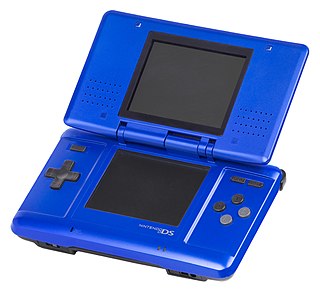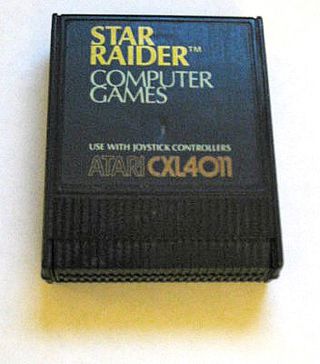
The Game Boy Advance (GBA) is a 32-bit handheld game console developed, manufactured, and marketed by Nintendo as the successor to the Game Boy Color. It was released in Japan on March 21, 2001, in North America on June 11, 2001, in the PAL region on June 22, 2001, and in mainland China as iQue Game Boy Advance on June 8, 2004.

A handheld game console, or simply handheld console, is a small, portable self-contained video game console with a built-in screen, game controls and speakers. Handheld game consoles are smaller than home video game consoles and contain the console, screen, speakers, and controls in one unit, allowing players to carry them and play them at any time or place.

A memory card is an electronic data storage device used for storing digital information, typically using flash memory. These are commonly used in digital portable electronic devices, such as digital cameras as well as in many early games consoles such as the Nintendo Wii. They allow adding memory to such devices using a card in a socket instead of protruding USB flash drives.

The Nintendo DS is a 32-bit foldable handheld game console produced by Nintendo, released globally across 2004 and 2005. The DS, an initialism for "Developers' System" or "Dual Screen", introduced distinctive new features to handheld games: two LCD screens working in tandem, a built-in microphone and support for wireless connectivity. Both screens are encompassed within a clamshell design similar to the Game Boy Advance SP. The Nintendo DS also features the ability for multiple DS consoles to directly interact with each other over Wi-Fi within a short range without the need to connect to an existing wireless network. Alternatively, they could interact online using the now-defunct Nintendo Wi-Fi Connection service. Its main competitor was Sony's PlayStation Portable during the seventh generation of video game consoles.

The Rumble Pack is a removable device from Nintendo that provides force feedback while playing video games. Games that support the Rumble Pak cause it to vibrate in select situations, such as when firing a weapon or receiving damage, to immerse the player in the game. Versions of the Rumble Pak are available for the Nintendo 64, the Nintendo DS, and the Nintendo DS Lite. A select few Game Boy Color and Game Boy Advance (GBA) games use a similar technology built into the game cartridge. Force feedback vibration has become a built-in standard feature in almost every home video game console controller since.

Action Replay is the brand name of a cheating device created by Datel. The Action Replay is available for many gaming systems including the Nintendo DS, Nintendo DSi, Nintendo 3DS, PlayStation Portable, PlayStation 2, GameCube, Game Boy Advance, and the Xbox. The name is derived from the first devices’ signature ability to pause the execution of the software and save the computer's state to disk or tape for future “replay”. The ability to manipulate the contents of memory in this paused state permitted the cheat functions for which the brand is now better known.
A softmod is a method of using software to modify the intended behavior of hardware, such as computer hardware, or video game consoles in a way that can overcome restrictions of the firmware, or install custom firmware.
Homebrew, when applied to video games, refers to software produced by hobbyists for proprietary video game consoles which are not intended to be user-programmable. The official documentation is often only available to licensed developers, and these systems may use storage formats that make distribution difficult, such as ROM cartridges or encrypted CD-ROMs. Many consoles have hardware restrictions to prevent unauthorized development.
A video game accessory is a distinct piece of hardware that is required to use a video game console, or one that enriches the video game's play experience. Essentially, video game accessories are everything except the console itself, such as controllers, memory, power adapters (AC), and audio/visual cables. Most video game consoles come with the accessories required to play games out of the box : one A/V cable, one AC cable, and a controller. Memory is usually the most required accessory outside of these, as game data cannot be saved to compact discs. The companies that manufacture video game consoles also make these accessories for replacement purposes as well as improving the overall experience. There is an entire industry of companies that create accessories for consoles as well, called third-party companies. The prices are often lower than those made by the maker of the console (first-party). This is usually achieved by avoiding licensing or using cheaper materials. For the mobile systems like the PlayStation Portable and Game Boy iterations, there are many accessories to make them more usable in mobile environments, such as mobile chargers, lighting to improve visibility, and cases to both protect and help organize the collection of system peripherals to. Newer accessories include many home-made things like mod chips to bypass manufacturing protection or homemade software.

The Nintendo Wi-Fi USB Connector is a wireless game adapter, developed by Nintendo and Buffalo Technology, which allows the Nintendo DS, Wii and 3DS users without a Wi-Fi connection or compatible Wi-Fi network to establish an Internet connection via a broadband-connected PC. When inserted into the host PC's USB port, the connector functions with the Nintendo DS, Wii, DSi and 3DS, permitting the user to connect to the Internet and play Nintendo games that require a Wi-Fi connection and access various other online services. According to the official Nintendo website, this product was the best-selling Nintendo accessory to date on 15 November 2007, but was discontinued in the same month. On September 9, 2005, Nintendo announced the Nintendo Wi-Fi Network Adapter, an 802.11g wireless router/bridge which serves a similar purpose.

The Nintendo DS Browser is a port of the Opera 8.5 web browser for use on the Nintendo DS, developed by Opera Software and Nintendo, and sold as a standalone game cartridge. Two versions were sold, one for the original Nintendo DS and one for the Nintendo DS Lite, each with a different Slot-2 memory expansion pack to fit the respective system.

A ROM cartridge, usually referred to in context simply as a cartridge, cart, or card, is a replaceable part designed to be connected to a consumer electronics device such as a home computer, video game console or, to a lesser extent, electronic musical instruments.

A game backup device, informally called a copier, is a device for backing up ROM data from a video game cartridge to a computer file called a ROM image and playing them back on the official hardware. Recently flash cartridges, especially on the Game Boy Advance and Nintendo DS platforms, only support the latter function; they cannot be used for backing up ROM data. Game backup devices also make it possible to develop homebrew software on video game systems. Game backup devices differ from modchips in that modchips are used in conjunction with systems that use generally available media such as CDs and DVDs, whereas game backup devices are used with systems that use cartridges.

The Nintendo DSi is a dual-screen handheld game console released by Nintendo. The console launched in Japan on November 1, 2008, and worldwide beginning in April 2009. It is the third iteration of the Nintendo DS, and its primary market rival was Sony's PlayStation Portable (PSP). The fourth iteration, entitled Nintendo DSi XL, is a larger model that launched in Japan on November 21, 2009, and worldwide beginning in March 2010. Development of the DSi began in late 2006, and the handheld was unveiled during an October 2008 Nintendo conference in Tokyo. Consumer demand convinced Nintendo to produce a slimmer handheld with larger screens than the DS Lite. Consequently, Nintendo removed the Game Boy Advance (GBA) cartridge slot to improve portability without sacrificing durability.

The Nintendo DSi system software is a discontinued set of updatable firmware versions, and a software frontend on the Nintendo DSi video game console. Updates, which are downloaded via the system's Internet connection, allow Nintendo to add and remove features and software. All updates also include all changes from previous updates.

Nintendo Game Cards are physical flash storage cards produced by Nintendo that contain video game software for the Nintendo DS, Nintendo 3DS, or Nintendo Switch families of consoles. They are the successor to the Game Boy Game Paks used for Nintendo's previous portable gaming consoles.

A dongle is a small piece of computer hardware that connects to a port on another device to provide it with additional functionality, or enable a pass-through to such a device that adds functionality.

The R4 is an unlicensed flash cartridge for the Nintendo DS handheld system. It allows ROMs and homebrew to be booted on the Nintendo DS handheld system from a microSD card. This allows the user to run homebrew applications, to store multiple games and MP3 music files on a single memory card, and to play games that have been backed up by the user.
Custom firmware, also known as aftermarket firmware, is an unofficial new or modified version of firmware created by third parties on devices such as video game consoles, mobile phones, and various embedded device types to provide new features or to unlock hidden functionality. In the video game console community, the term is often written as custom firmware or simply CFW, referring to an altered version of the original system software inside a video game console such as the PlayStation Portable, PlayStation 3, PlayStation Vita/PlayStation TV, PlayStation 4, Nintendo 3DS, Wii U and Nintendo Switch. Installing custom firmware on some devices requires bootloader unlocking.

















